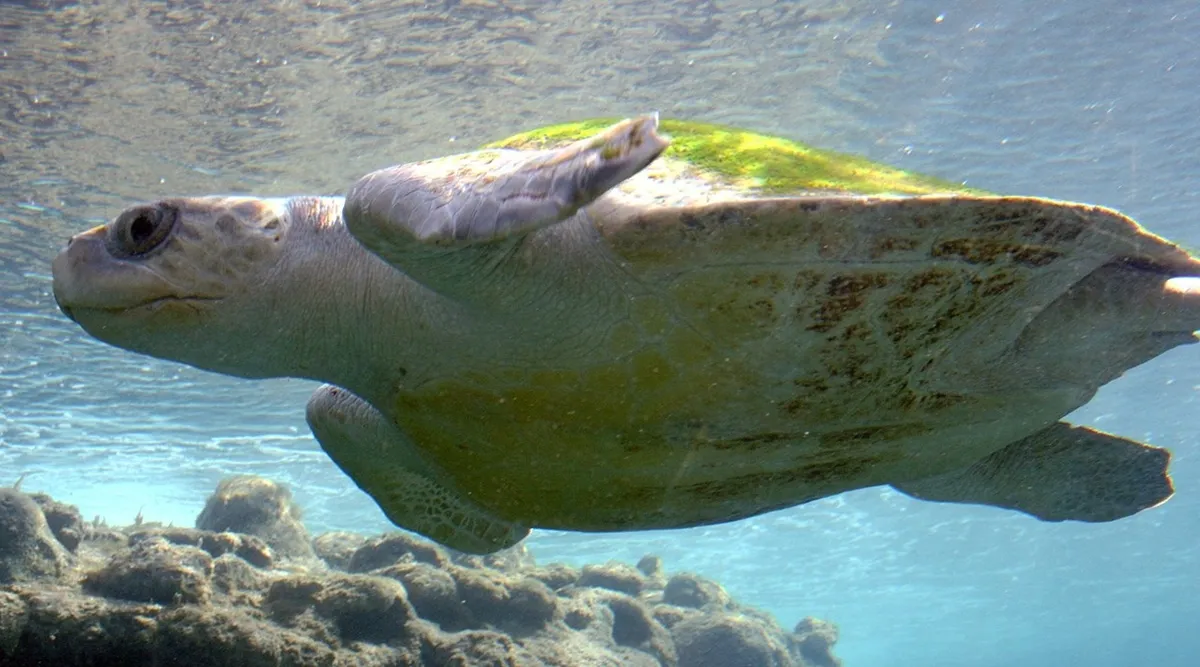 Olive ridley sea turtle at Kélonia, an aquarium in Saint-Leu, Réunion. (Image: Wikipedia)
Olive ridley sea turtle at Kélonia, an aquarium in Saint-Leu, Réunion. (Image: Wikipedia)Researchers from the Wildlife Institute of India (WII), Dehradun and the Mangrove Foundation, an autonomous body under the state government, tagged five female adult Olive Ridley turtles with a satellite device to monitor their path. Dr R Suresh Kumar, senior scientist from the Department of Endangered Species Management, WII, Dehradun, talks about the need to study Olive Ridley turtles, the most abundant sea turtle in the world, and their migratory patterns.
What is the satellite tagging project of Olive Ridley turtles and its importance?
Mass nesting, in which thousands of Olive Ridley turtles emerge from the ocean simultaneously to lay their eggs, is witnessed along the Odisha coast. Nesting has been recorded along the Maharashtra coastline but it is not mass nesting. There’s always been interest as to why similar mass nesting does not happen on the west coast. The Olive Ridley turtles that nest along the Maharashtra coastline are a different population known as solitary nesters. We have satellite-tagged five sea turtles from Maharashtra. This is the first study to understand the behaviour of solitary Olive Ridley turtles along the west coast and in the Arabian Sea basin — how they are using the nearshore areas, how far they go into the open waters and if they are going to the nearshore areas then what is the behaviour, are they resident or migratory species. If they are migrants then where exactly are they coming from. If the turtles on the Maharashtra coastline are resting in the water near the nesting beaches, we want to identify the hotspots. Once we have an understanding of those hotspots, the management can use this information to inform the fishermen that turtles reside there and fishing can be avoided.
It has been five months since the first turtle was tagged in Ratnagiri. What has the study revealed until now?
Subscriber Only Stories
One finding we are excited about is the migration of the turtles. We thought they travel into the deep sea further down to Lakshadweep or drift towards Oman, the Somali coastline and return later. We haven’t seen anything like that, these turtles are possibly resident turtles. Well, these turtles don’t know any political boundaries, but they’ve associated themselves with certain characteristic habitats of the Arabian Sea. We see that these turtles remain on the continental shelf of the west coast. Two or three turtles went to Karnataka and Goa but even here, they remained on the continental shelf. On some occasions, they have gone to the continental slope, the edge from which the continental shelf slope begins, when it begins to get deeper. I was expecting the Olive Ridleys in the Arabian Sea to go to the deeper part. Interestingly, a tracking study done by researchers on the Omani coastline shows those turtles sticking only to the continental slope and going up to Pakistan. This indicates that all these populations don’t use the deeper water. The Arabian coastline, especially the continental shelf, is very rich. There is a lot of fish available. In the Arabian Sea basin, there is something known as the Death Zone. These Death Zones are generally deprived of dissolved oxygen. There are hardly any species that would survive in Death Zones so, most species avoid them. I think because of the presence of these Death Zones, our understanding of this is very limited.
In the last five months, you have lost contact with three of the five turtles. How is this affecting the study?
It will affect our understanding of these species. Ideally, we would need to track these turtles for a long time so that at least for one full circle or one year we can know the inter-annual differences. Like we did the tagging in the winter month, and winter or early summer or spring we would like to call it. Now the monsoon, after the monsoon there is post-monsoon, then the turtles possibly arrive and there can be differences when they use the waters. The same thing can be completely different next year if ocean circulation is different. So, ideally, we are going to miss out on that data because of this premature non-transmission of the tag. Of course, the project has indeed been affected because the transmitters haven’t performed.
Are the other two transmitters in place or are they also facing any issues?
The remaining ones are fine. The turtle is transmitting. But it doesn’t move much, it’s moving in the same area it is in.
Any plans of tagging hatchlings in the future or once the technology advances are we going to think about tagging hatchlings?
Unfortunately, we can’t tag hatchlings because they’re too small in size to put transmitters on. There has been advancement in satellite marine tracking, there are much smaller transmitters that are fit to be deployed on younger individuals. However, I think it’s important to deploy transmitters on adult individuals because our understanding of this is still poor so we should be investing more in adults rather than going into younger individuals.
- The Indian Express website has been rated GREEN for its credibility and trustworthiness by Newsguard, a global service that rates news sources for their journalistic standards.

